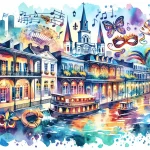The Presbytère, an architectural jewel situated in New Orleans’ French Quarter, stands as a testament to the city’s rich heritage. This distinctive Spanish Colonial structure has graced the city’s skyline for over two centuries, making it an integral part of the local landscape.
In This Article
TL;DR
- The Presbytère’s unique architectural design and its prominent role in New Orleans’ skyline.
- The museum’s dual focus on Louisiana’s history and the renowned Mardi Gras tradition.
- The Presbytère’s commitment to community engagement and education initiatives.
The Architectural Marvel of the Presbytère
Constructed in 1791, the Presbytère was originally designed as a residence for Capuchin monks. Its Spanish Colonial architecture, characterized by stucco walls, wrought-iron balconies, and a red-tiled roof, reflects the influence of Spanish settlers who arrived in New Orleans during the 18th century. Over the years, the building has undergone various transformations, transitioning from a religious structure to a courthouse and eventually finding its current purpose as a museum.
Situated adjacent to the iconic St. Louis Cathedral, the Presbytère forms a striking architectural duo with the Cabildo, another historic building that once served as the Spanish colonial government’s headquarters. Together, these two structures create a visually stunning backdrop for Jackson Square, one of the most iconic landmarks in the French Quarter.
A Journey Through Louisiana’s Rich History
Step inside the Presbytère, and you’ll embark on a captivating journey through Louisiana’s storied past. The museum’s Louisiana History Galleries offer an in-depth exploration of the state’s diverse cultural tapestry, from the indigenous tribes that first inhabited the region to the arrival of European settlers and the subsequent blending of cultures.
Immerse yourself in the narratives of key historical figures, such as Jean-Baptiste Le Moyne de Bienville, the founder of New Orleans, and learn about pivotal events that shaped the city’s destiny, including the Louisiana Purchase of 1803. Through interactive exhibits, artifacts, and multimedia displays, the museum brings these stories to life, providing visitors with a deeper understanding of Louisiana’s unique heritage.
Celebrating Mardi Gras Year-Round
No visit to the Presbytère would be complete without experiencing the museum’s renowned Mardi Gras exhibit. This vibrant display showcases the rich traditions and cultural significance of one of the world’s most iconic celebrations. Marvel at the intricate costumes, colorful masks, and elaborate floats that have become synonymous with the Mardi Gras festivities in New Orleans.
Through photographs, artifacts, and interactive displays, visitors can gain insights into the history and evolution of Mardi Gras, from its origins as a celebration of indulgence before Lent to its modern-day incarnation as a global spectacle. The exhibit not only entertains but also educates, shedding light on the cultural significance of this beloved tradition in Louisiana.
Community Engagement and Educational Programs
Beyond its role as a museum, the Presbytère serves as a hub for community engagement and education. The institution hosts a variety of programs and events aimed at promoting local culture and history to both visitors and residents alike. From guided tours and lectures to workshops and educational outreach initiatives, the Presbytère actively fosters a deeper appreciation for New Orleans’ rich heritage.
Partnerships with local schools and cultural organizations further amplify the museum’s educational efforts, ensuring that the stories and traditions of Louisiana are passed down to future generations. By engaging with the community, the Presbytère not only preserves the past but also shapes the cultural landscape of the present and future.
Planning Your Visit
To fully immerse yourself in the Presbytère’s offerings, it’s essential to plan your visit accordingly. The museum is open daily, with extended hours during peak seasons. Guided tours are available, providing visitors with an in-depth exploration of the exhibits and the opportunity to engage with knowledgeable docents.
Accessibility features, such as ramps and elevators, ensure that the museum is inclusive and welcoming to all visitors. Additionally, the Presbytère’s location in the heart of the French Quarter allows visitors to seamlessly explore nearby attractions, such as the St. Louis Cathedral, Jackson Square, and the vibrant streets lined with historic buildings and lively music venues.
The Presbytère in the Digital Age
In the era of digital innovation, the Presbytère has embraced technology to enhance the visitor experience and increase accessibility. Virtual tours and online resources offer a glimpse into the museum’s exhibits for those unable to visit in person, while interactive displays and multimedia installations within the museum itself provide an immersive and engaging experience for on-site visitors.
The Presbytère’s active social media presence further extends its reach, engaging with a global audience and sharing the stories and traditions of New Orleans with people around the world. By embracing digital platforms, the museum ensures that Louisiana’s rich cultural heritage remains accessible and relevant in the modern age.
Preservation Efforts and Future Plans
Preserving the Presbytère’s historical integrity is an ongoing endeavor, with dedicated efforts to maintain the building’s architectural authenticity and safeguard its invaluable collections. Ongoing restoration projects and conservation initiatives ensure that this cultural treasure remains a vibrant part of New Orleans’ landscape for generations to come.
Looking to the future, the Presbytère has exciting plans for new exhibitions and projects that will further enrich the visitor experience and deepen the understanding of Louisiana’s cultural tapestry. From exploring the state’s culinary traditions to highlighting the stories of underrepresented communities, the museum remains committed to showcasing the diversity and richness of New Orleans’ heritage.
The Presbytère’s Place in New Orleans’ Cultural Landscape
The Presbytère stands as a shining example of New Orleans’ commitment to preserving and celebrating its cultural identity. Alongside other renowned institutions, such as the New Orleans Museum of Art and the Ogden Museum of Southern Art, the Presbytère plays a vital role in promoting New Orleans as a destination for cultural tourism.
By offering a window into the city’s past and present, the museum not only enriches the experiences of visitors but also instills a sense of pride and appreciation among locals for the unique heritage that defines their beloved city. The Presbytère’s influence extends far beyond its physical walls, shaping the cultural landscape of New Orleans and ensuring that its vibrant traditions continue to thrive for generations to come.






